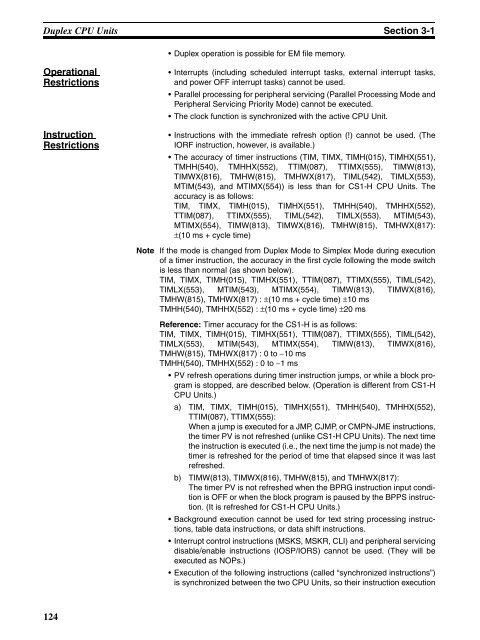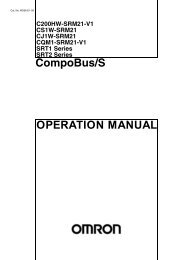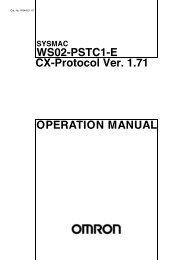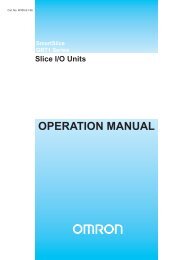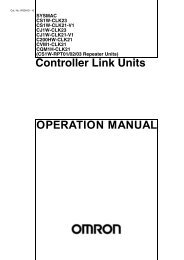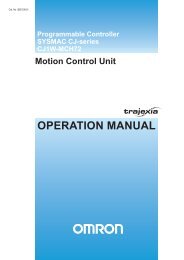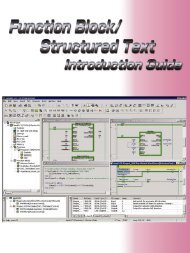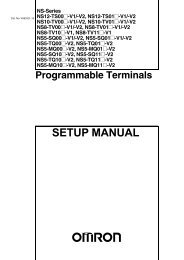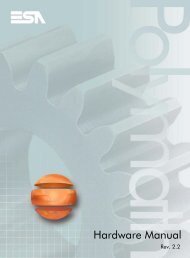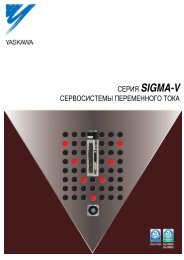- Page 1 and 2:
Cat. No. W405-E1-06 SYSMAC CS Serie
- Page 4 and 5:
Notice: OMRON products are manufact
- Page 6 and 7:
Use the above display to confirm th
- Page 8 and 9:
Function Support by Unit Version CS
- Page 10 and 11:
Unit Versions and Programming Devic
- Page 12 and 13:
TABLE OF CONTENTS PRECAUTIONS . . .
- Page 14 and 15:
TABLE OF CONTENTS 8-19 Task Flags .
- Page 16 and 17:
About this Manual: This manual desc
- Page 18 and 19:
Read and Understand this Manual Ple
- Page 20 and 21:
Disclaimers CHANGE IN SPECIFICATION
- Page 22 and 23:
PRECAUTIONS This section provides g
- Page 24 and 25:
Safety Precautions 3 !WARNING Do no
- Page 26 and 27:
Application Precautions 5 !Caution
- Page 28 and 29:
Application Precautions 5 Note The
- Page 30 and 31:
Application Precautions 5 Do not ap
- Page 32 and 33:
Conformance to EC Directives 6 6 Co
- Page 34 and 35:
Conformance to EC Directives 6 Diod
- Page 36 and 37:
SECTION 1 Features and System Confi
- Page 38 and 39:
CS1D Duplex System Overview and Fea
- Page 40 and 41:
CS1D Duplex System Overview and Fea
- Page 42 and 43:
System Configuration Section 1-2 1-
- Page 44 and 45:
System Configuration Section 1-2 Na
- Page 46 and 47:
System Configuration Section 1-2 Na
- Page 48 and 49:
System Configuration Section 1-2 CS
- Page 50 and 51:
SECTION 2 Specifications, Nomenclat
- Page 52 and 53:
Specifications Section 2-1 2-1 Spec
- Page 54 and 55:
Specifications Section 2-1 Item Spe
- Page 56 and 57:
Specifications Section 2-1 Specific
- Page 58 and 59:
Specifications Section 2-1 CPU proc
- Page 60 and 61:
Specifications Section 2-1 CIO (Cor
- Page 62 and 63:
Specifications Section 2-1 Function
- Page 64 and 65:
Specifications Section 2-1 2-1-4 Ge
- Page 66 and 67:
Configuration Devices Section 2-2 D
- Page 68 and 69:
Configuration Devices Section 2-2 C
- Page 70 and 71:
Configuration Devices Section 2-2 2
- Page 72 and 73:
Configuration Devices Section 2-2 C
- Page 74 and 75:
Configuration Devices Section 2-2 R
- Page 76 and 77:
Configuration Devices Section 2-2 D
- Page 78 and 79:
Configuration Devices Section 2-2 E
- Page 80 and 81:
Duplex Unit Section 2-3 Longdistanc
- Page 82 and 83:
Duplex Unit Section 2-3 Duplex Unit
- Page 84 and 85:
Duplex Unit Section 2-3 by peripher
- Page 86 and 87:
Duplex Unit Section 2-3 Indicator S
- Page 88 and 89:
Duplex Unit Section 2-3 Indicator S
- Page 90 and 91:
CPU Units Section 2-4 2-4-2 Compone
- Page 92 and 93:
CPU Units Section 2-4 MCPWR Indicat
- Page 94 and 95:
CPU Units Section 2-4 2-4-3 CPU Uni
- Page 96 and 97:
CPU Units Section 2-4 2-4-4 Battery
- Page 98 and 99:
File Memory Section 2-5 2-5-1 File
- Page 100 and 101:
File Memory Section 2-5 Simple Back
- Page 102 and 103:
File Memory Section 2-5 Reading and
- Page 104 and 105:
File Memory Section 2-5 Removing th
- Page 106 and 107:
Programming Devices Section 2-6 2-6
- Page 108: Programming Devices Section 2-6 CX-
- Page 111 and 112: Programming Devices Section 2-6 USB
- Page 113 and 114: Programming Devices Section 2-6 78
- Page 115 and 116: Programming Devices Section 2-6 Lea
- Page 117 and 118: Power Supply Units Section 2-7 2-7
- Page 119 and 120: Power Supply Units Section 2-7 2-7-
- Page 121 and 122: Backplanes Section 2-8 CPU Backplan
- Page 123 and 124: Backplanes Section 2-8 CPU Backplan
- Page 125 and 126: Units for Duplex CPU, Dual I/O Expa
- Page 127 and 128: Units for Duplex CPU, Dual I/O Expa
- Page 129 and 130: Units on CS1D Long-distance Expansi
- Page 131 and 132: Units on CS1D Long-distance Expansi
- Page 133 and 134: Basic I/O Units Section 2-11 2-11 B
- Page 135 and 136: Basic I/O Units Section 2-11 2-11-2
- Page 137 and 138: Basic I/O Units Section 2-11 102 I
- Page 139 and 140: Unit Current Consumption Section 2-
- Page 141 and 142: Unit Current Consumption Section 2-
- Page 143 and 144: CPU Bus Unit Setting Area Capacity
- Page 145 and 146: I/O Table Settings Section 2-14 2-1
- Page 147 and 148: I/O Table Settings Section 2-14 2-1
- Page 149 and 150: Duplex CPU Units Section 3-1 3-1 Du
- Page 151 and 152: Duplex CPU Units Section 3-1 116 Cy
- Page 153 and 154: Duplex CPU Units Section 3-1 118 Fa
- Page 155 and 156: Duplex CPU Units Section 3-1 3-1-4
- Page 157: Duplex CPU Units Section 3-1 122 Ma
- Page 161 and 162: Duplex CPU Units Section 3-1 126 No
- Page 163 and 164: Duplex Communications Units Section
- Page 165 and 166: Duplex Connecting Cables Section 3-
- Page 167 and 168: Duplex Connecting Cables Section 3-
- Page 169 and 170: Introduction Section 4-1 4-1 Introd
- Page 171 and 172: Basic Procedures Section 4-2 4-2 Ba
- Page 173 and 174: Basic Procedures Section 4-2 Settin
- Page 175 and 176: Basic Procedures Section 4-2 6. PLC
- Page 177 and 178: Basic Procedures Section 4-2 142 No
- Page 179 and 180: Basic Procedures Section 4-2 144 No
- Page 181 and 182: Basic Procedures Section 4-2 146 tu
- Page 183 and 184: Basic Procedures Section 4-2 148 On
- Page 185 and 186: Fail-safe Circuits Section 5-1 5-1
- Page 187 and 188: Installation Section 5-2 152 Locati
- Page 189 and 190: Installation Section 5-2 5-2-2 Inst
- Page 191 and 192: Installation Section 5-2 5-2-3 Moun
- Page 193 and 194: Installation Section 5-2 5-2-6 I/O
- Page 195 and 196: Installation Section 5-2 160 Total
- Page 197 and 198: Installation Section 5-2 162 IC102
- Page 199 and 200: Installation Section 5-2 164 into t
- Page 201 and 202: Power Supply Wiring Section 5-3 166
- Page 203 and 204: Wiring Methods Section 5-4 AC Power
- Page 205 and 206: Wiring Methods Section 5-4 CS1D-PD0
- Page 207 and 208: Wiring Methods Section 5-4 172 Do n
- Page 209 and 210:
Wiring Methods Section 5-4 Terminal
- Page 211 and 212:
Wiring Methods Section 5-4 CS-serie
- Page 213 and 214:
Wiring Methods Section 5-4 Connecti
- Page 215 and 216:
Wiring Methods Section 5-4 Connecti
- Page 217 and 218:
Wiring Methods Section 5-4 AC Input
- Page 219 and 220:
Wiring Methods Section 5-4 184 Use
- Page 221 and 222:
Wiring Methods Section 5-4 186
- Page 223 and 224:
Overview of PLC Setup Section 6-1 6
- Page 225 and 226:
Overview of PLC Setup Section 6-1 T
- Page 227 and 228:
Specific PLC Setup Settings Section
- Page 229 and 230:
Specific PLC Setup Settings Section
- Page 231 and 232:
Specific PLC Setup Settings Section
- Page 233 and 234:
Specific PLC Setup Settings Section
- Page 235 and 236:
Specific PLC Setup Settings Section
- Page 237 and 238:
Specific PLC Setup Settings Section
- Page 239 and 240:
Specific PLC Setup Settings Section
- Page 241 and 242:
Specific PLC Setup Settings Section
- Page 243 and 244:
Specific PLC Setup Settings Section
- Page 245 and 246:
Specific PLC Setup Settings Section
- Page 247 and 248:
Specific PLC Setup Settings Section
- Page 249 and 250:
Specific PLC Setup Settings Section
- Page 251 and 252:
Specific PLC Setup Settings Section
- Page 253 and 254:
Specific PLC Setup Settings Section
- Page 255 and 256:
Specific PLC Setup Settings Section
- Page 257 and 258:
I/O Allocations Section 7-1 7-1 I/O
- Page 259 and 260:
I/O Allocations Section 7-1 Creatin
- Page 261 and 262:
I/O Allocations Section 7-1 226 be
- Page 263 and 264:
I/O Allocation Methods Section 7-2
- Page 265 and 266:
I/O Allocation Methods Section 7-2
- Page 267 and 268:
I/O Allocation Methods Section 7-2
- Page 269 and 270:
Allocating First Words to Racks Sec
- Page 271 and 272:
Allocating First Words to Racks Sec
- Page 273 and 274:
Allocating First Words to Slots (Si
- Page 275 and 276:
Detailed Information on I/O Table C
- Page 277 and 278:
Data Exchange with CPU Bus Units Se
- Page 279 and 280:
Data Exchange with CPU Bus Units Se
- Page 281 and 282:
Online Addition of Units and Backpl
- Page 283 and 284:
Online Addition of Units and Backpl
- Page 285 and 286:
Online Addition of Units and Backpl
- Page 287 and 288:
Introduction Section 8-1 8-1 Introd
- Page 289 and 290:
I/O Memory Areas Section 8-2 DM Are
- Page 291 and 292:
I/O Memory Areas Section 8-2 Link A
- Page 293 and 294:
I/O Memory Areas Section 8-2 Extend
- Page 295 and 296:
I/O Area Section 8-3 Area External
- Page 297 and 298:
I/O Area Section 8-3 Immediate Refr
- Page 299 and 300:
I/O Area Section 8-3 Output Bits 26
- Page 301 and 302:
CS-series DeviceNet Area Section 8-
- Page 303 and 304:
CPU Bus Unit Area Section 8-6 268 A
- Page 305 and 306:
Inner Board Area Section 8-7 8-7 In
- Page 307 and 308:
Work Area Section 8-9 Special I/O U
- Page 309 and 310:
Auxiliary Area Section 8-11 8-11 Au
- Page 311 and 312:
Auxiliary Area Section 8-11 ■ Pre
- Page 313 and 314:
Auxiliary Area Section 8-11 ■ Dup
- Page 315 and 316:
Auxiliary Area Section 8-11 Duplex
- Page 317 and 318:
Auxiliary Area Section 8-11 CPU Sta
- Page 319 and 320:
Auxiliary Area Section 8-11 Online
- Page 321 and 322:
Auxiliary Area Section 8-11 Name Ad
- Page 323 and 324:
Auxiliary Area Section 8-11 Other F
- Page 325 and 326:
Auxiliary Area Section 8-11 Special
- Page 327 and 328:
Auxiliary Area Section 8-11 ■ Dat
- Page 329 and 330:
Auxiliary Area Section 8-11 ■ Mem
- Page 331 and 332:
Auxiliary Area Section 8-11 Too Man
- Page 333 and 334:
Auxiliary Area Section 8-11 ■ Oth
- Page 335 and 336:
Auxiliary Area Section 8-11 Communi
- Page 337 and 338:
Auxiliary Area Section 8-11 ■ Inf
- Page 339 and 340:
TR (Temporary Relay) Area Section 8
- Page 341 and 342:
Timer Area Section 8-13 306 The fol
- Page 343 and 344:
Data Memory (DM) Area Section 8-15
- Page 345 and 346:
Extended Data Memory (EM) Area Sect
- Page 347 and 348:
Index Registers Section 8-17 312 In
- Page 349 and 350:
Index Registers Section 8-17 Index
- Page 351 and 352:
Index Registers Section 8-17 316 Ta
- Page 353 and 354:
Task Flags Section 8-19 318 2. The
- Page 355 and 356:
Condition Flags Section 8-20 320 Re
- Page 357 and 358:
Clock Pulses Section 8-21 8-21 Cloc
- Page 359 and 360:
Parameter Areas Section 8-22 8-22-3
- Page 361 and 362:
Parameter Areas Section 8-22 326
- Page 363 and 364:
328 9-5-16 Data Control Instruction
- Page 365 and 366:
CPU Unit Operation Section 9-1 9-1-
- Page 367 and 368:
CPU Unit Operation Section 9-1 9-1-
- Page 369 and 370:
CPU Unit Operation Section 9-1 334
- Page 371 and 372:
CPU Unit Operating Modes Section 9-
- Page 373 and 374:
Power OFF Operation Section 9-3 9-3
- Page 375 and 376:
Power OFF Operation Section 9-3 340
- Page 377 and 378:
Computing the Cycle Time Section 9-
- Page 379 and 380:
Computing the Cycle Time Section 9-
- Page 381 and 382:
Computing the Cycle Time Section 9-
- Page 383 and 384:
Computing the Cycle Time Section 9-
- Page 385 and 386:
Computing the Cycle Time Section 9-
- Page 387 and 388:
Computing the Cycle Time Section 9-
- Page 389 and 390:
Computing the Cycle Time Section 9-
- Page 391 and 392:
Computing the Cycle Time Section 9-
- Page 393 and 394:
Instruction Execution Times and Num
- Page 395 and 396:
Instruction Execution Times and Num
- Page 397 and 398:
Instruction Execution Times and Num
- Page 399 and 400:
Instruction Execution Times and Num
- Page 401 and 402:
Instruction Execution Times and Num
- Page 403 and 404:
Instruction Execution Times and Num
- Page 405 and 406:
Instruction Execution Times and Num
- Page 407 and 408:
Instruction Execution Times and Num
- Page 409 and 410:
Instruction Execution Times and Num
- Page 411 and 412:
Instruction Execution Times and Num
- Page 413 and 414:
Instruction Execution Times and Num
- Page 415 and 416:
Instruction Execution Times and Num
- Page 417 and 418:
Instruction Execution Times and Num
- Page 419 and 420:
Instruction Execution Times and Num
- Page 421 and 422:
Instruction Execution Times and Num
- Page 423 and 424:
Error Log Section 10-1 10-1 Error L
- Page 425 and 426:
Error Processing Section 10-2 10-2-
- Page 427 and 428:
Error Processing Section 10-2 10-2-
- Page 429 and 430:
Error Processing Section 10-2 Duple
- Page 431 and 432:
Error Processing Section 10-2 Opera
- Page 433 and 434:
Error Processing Section 10-2 Troub
- Page 435 and 436:
Error Processing Section 10-2 Progr
- Page 437 and 438:
Error Processing Section 10-2 Troub
- Page 439 and 440:
Error Processing Section 10-2 Error
- Page 441 and 442:
Error Processing Section 10-2 Other
- Page 443 and 444:
Error Processing Section 10-2 10-2-
- Page 445 and 446:
Error Processing Section 10-2 Duple
- Page 447 and 448:
Error Processing Section 10-2 10-2-
- Page 449 and 450:
Error Processing Section 10-2 10-2-
- Page 451 and 452:
Troubleshooting Racks and Units Sec
- Page 453 and 454:
Troubleshooting Racks and Units Sec
- Page 455 and 456:
Troubleshooting Errors in Duplex Co
- Page 457 and 458:
Troubleshooting Errors in Duplex Co
- Page 459 and 460:
Inspections Section 11-1 11-1 Inspe
- Page 461 and 462:
Replacing User-serviceable Parts Se
- Page 463 and 464:
Replacing User-serviceable Parts Se
- Page 465 and 466:
Replacing User-serviceable Parts Se
- Page 467 and 468:
Replacing a CPU Unit Section 11-3 4
- Page 469 and 470:
Replacing a CPU Unit Section 11-3 4
- Page 471 and 472:
Online Replacement of I/O Units, Sp
- Page 473 and 474:
Online Replacement of I/O Units, Sp
- Page 475 and 476:
Online Replacement of I/O Units, Sp
- Page 477 and 478:
Online Replacement of I/O Units, Sp
- Page 479 and 480:
Online Replacement of I/O Units, Sp
- Page 481 and 482:
Online Replacement of I/O Units, Sp
- Page 483 and 484:
Online Replacement of I/O Units, Sp
- Page 485 and 486:
Online Replacement of I/O Units, Sp
- Page 487 and 488:
Online Replacement of I/O Units, Sp
- Page 489 and 490:
Online Replacement of I/O Units, Sp
- Page 491 and 492:
Replacement of Expansion Units Sect
- Page 493 and 494:
Replacing the Duplex Unit Section 1
- Page 495 and 496:
Replacing the Duplex Unit Section 1
- Page 497 and 498:
Specifications of Basic I/O Units a
- Page 499 and 500:
Specifications of Basic I/O Units a
- Page 501 and 502:
Specifications of Basic I/O Units a
- Page 503 and 504:
Specifications of Basic I/O Units a
- Page 505 and 506:
Specifications of Basic I/O Units a
- Page 507 and 508:
Specifications of Basic I/O Units a
- Page 509 and 510:
Specifications of Basic I/O Units a
- Page 511 and 512:
Specifications of Basic I/O Units a
- Page 513 and 514:
Specifications of Basic I/O Units a
- Page 515 and 516:
Specifications of Basic I/O Units a
- Page 517 and 518:
Specifications of Basic I/O Units a
- Page 519 and 520:
Specifications of Basic I/O Units a
- Page 521 and 522:
Specifications of Basic I/O Units a
- Page 523 and 524:
Specifications of Basic I/O Units a
- Page 525 and 526:
Specifications of Basic I/O Units a
- Page 527 and 528:
Specifications of Basic I/O Units a
- Page 529 and 530:
Specifications of Basic I/O Units a
- Page 531 and 532:
Specifications of Basic I/O Units a
- Page 533 and 534:
Specifications of Basic I/O Units a
- Page 535 and 536:
Specifications of Basic I/O Units a
- Page 537 and 538:
Auxiliary Area Allocations Appendix
- Page 539 and 540:
Auxiliary Area Allocations Appendix
- Page 541 and 542:
Auxiliary Area Allocations Appendix
- Page 543 and 544:
Auxiliary Area Allocations Appendix
- Page 545 and 546:
Auxiliary Area Allocations Appendix
- Page 547 and 548:
Auxiliary Area Allocations Appendix
- Page 549 and 550:
Auxiliary Area Allocations Appendix
- Page 551 and 552:
Auxiliary Area Allocations Appendix
- Page 553 and 554:
Auxiliary Area Allocations Appendix
- Page 555 and 556:
Auxiliary Area Allocations Appendix
- Page 557 and 558:
Auxiliary Area Allocations Appendix
- Page 559 and 560:
Auxiliary Area Allocations Appendix
- Page 561 and 562:
Auxiliary Area Allocations Appendix
- Page 563 and 564:
Auxiliary Area Allocations Appendix
- Page 565 and 566:
Auxiliary Area Allocations Appendix
- Page 567 and 568:
Auxiliary Area Allocations Appendix
- Page 569 and 570:
Auxiliary Area Allocations Appendix
- Page 571 and 572:
Auxiliary Area Allocations Appendix
- Page 573 and 574:
Auxiliary Area Allocations Appendix
- Page 575 and 576:
Auxiliary Area Allocations Appendix
- Page 577 and 578:
Auxiliary Area Allocations Appendix
- Page 579 and 580:
Auxiliary Area Allocations Appendix
- Page 581 and 582:
Auxiliary Area Allocations Appendix
- Page 583 and 584:
Auxiliary Area Allocations Appendix
- Page 585 and 586:
Memory Map of PLC Memory Addresses
- Page 587 and 588:
PLC Setup Coding Sheets for Program
- Page 589 and 590:
PLC Setup Coding Sheets for Program
- Page 591 and 592:
PLC Setup Coding Sheets for Program
- Page 593 and 594:
PLC Setup Coding Sheets for Program
- Page 595 and 596:
PLC Setup Coding Sheets for Program
- Page 597 and 598:
PLC Setup Coding Sheets for Program
- Page 599 and 600:
PLC Setup Coding Sheets for Program
- Page 601 and 602:
Precautions in Replacing CS1-H PLCs
- Page 603 and 604:
Precautions in Replacing CS1-H PLCs
- Page 605 and 606:
Precautions in Replacing CS1-H PLCs
- Page 607 and 608:
Precautions in Replacing CS1-H PLCs
- Page 609 and 610:
Connecting to the RS-232C Port on t
- Page 611 and 612:
Connecting to the RS-232C Port on t
- Page 613 and 614:
Connecting to the RS-232C Port on t
- Page 615 and 616:
Connecting to the RS-232C Port on t
- Page 617 and 618:
Connecting to the RS-232C Port on t
- Page 619 and 620:
CJ1W-CIF11 RS-422A Converter Append
- Page 621 and 622:
CJ1W-CIF11 RS-422A Converter Append
- Page 623 and 624:
CJ1W-CIF11 RS-422A Converter Append
- Page 625 and 626:
590 settings, 325 CPU operating swi
- Page 627 and 628:
592 Flash Memory Error, 294, 531 fl
- Page 629 and 630:
594 peripheral port related flags/b
- Page 632 and 633:
Revision History A manual revision
- Page 634 and 635:
Revision History Revision code Date
- Page 636 and 637:
OMRON Corporation Control Devices D


